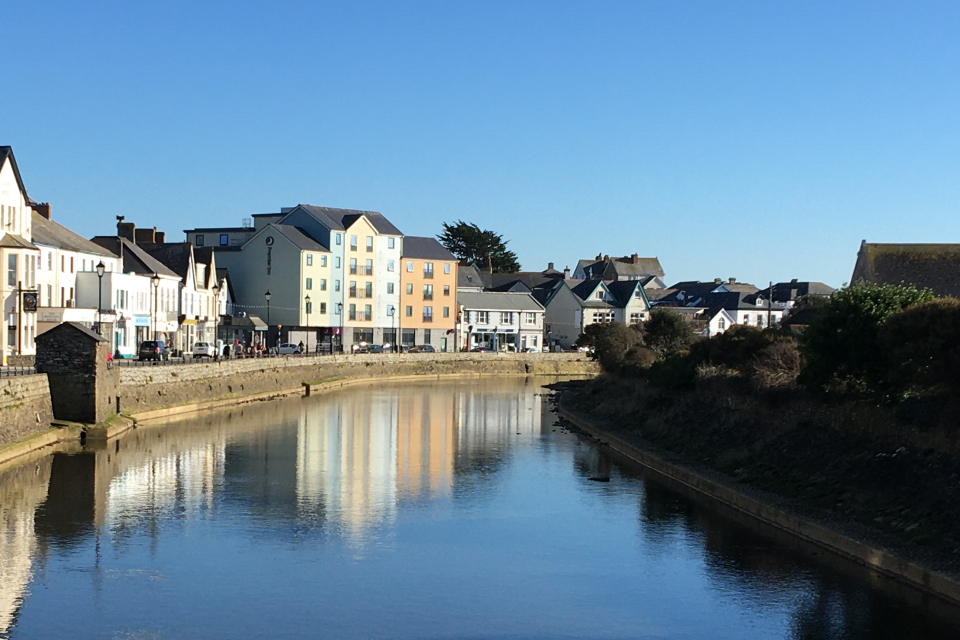Bude: improving flood defences and habitats
Updated 16 April 2024
Background
The Bude flood defence and river restoration scheme is a £2.1 million scheme to improve the existing flood alleviation scheme. It will also restore the ecological potential of the River Neet between Whalesborough Weir and Pethericks Mill Nature Reserve.
Bude has a long history of flooding from several sources:
- the River Neet
- Bude canal
- tidal surges
- storm waves

The River Neet as it flows through the town
The original Bude flood alleviation scheme was built after an extreme flood event in the 1950s. The scheme was later updated following a major fluvial flood in 1993.
Over time some parts of the scheme have declined in condition. These now needed work to maintain the design standard of protection it provides.
The parts of the scheme which required attention were:
-
the earth flood embankment to the rear of Bude tourist information centre running between the canal and Bencoolen Bridge
-
the masonry-faced embankment on Ergue-Gaberic Way between the Masonic Hall and Nanny Moore’s Bridge
Since the construction of the existing Bude flood alleviation scheme, Bude has continued to be affected by severe flood events.
The most recent events are:
- June 1993 - 71 residential and non-residential properties were flooded due to fluvial and surface water flooding
- August 2004 - the river exceeded the defences at Bencoolen Bridge
- March 2008 - high spring tides and strong winds resulted in coastal flooding
- January and February 2014 - high tide and wave progression up the River Neet resulted in defence overtopping at Nanny Moore’s Bridge and flooding of properties, exceeding the defence levels along the recreation ground and flooding the area around Leven Cottages
Whenever there are coastal flood warnings, Environment Agency Field Services teams provide pumps to remove water caused by waves over-topping the defences.
Scheme details
The scheme received £2.1 million funding from the government’s £170 million fund to accelerate the delivery of flood risk management schemes nationally.
The Crescent flood defence and river restoration project will better protect the local community and economy from flood events. This includes the increase in future flood events predicted because of climate change.
The work:
- strengthened the existing flood defences
- provides a solid foundation for future scheme improvements
- protect 22 residential properties and 15 commercial and community properties along The Crescent and Ergue-Gaberic Way, between the River Neet and Bude Canal
The work focused on the renewal of the flood defence along Ergue-Gaberic Way. This work includes the construction of a new flood wall on the landward face of the bank behind the existing roadside kerb.
Having completed the construction along Ergue-Gaberic Way, we will replant the top of the bank with a selection of native plant species. This will help to:
- improve the habitat
- restore the earth flood embankment to the rear of the tourist information centre
- improve maintenance access
River restoration
The project includes a river restoration element that focuses on the River Neet upstream of Bude between Whalesbourough Weir and Pethericks Mill Nature Reserve.
The Water Framework Directive is a European directive which aims to protect and improve the water environment. Under the directive, the River Neet currently has moderate ecological potential. The river must achieve good ecological potential by 2027.
The River Restoration Centre has investigated potential measures to improve the status of the watercourse. These include:
- in-channel enhancements such as narrowing and creating pinch points
- tree planting, which will encourage channel morphological diversity and improvements in habitat quality for a range of species, primarily fish
We will put these mitigation measures in place along this reach of the channel to help increase the ecological potential of the watercourse.
Contact details
For further information, email DCISenquiries@environment-agency.gov.uk

